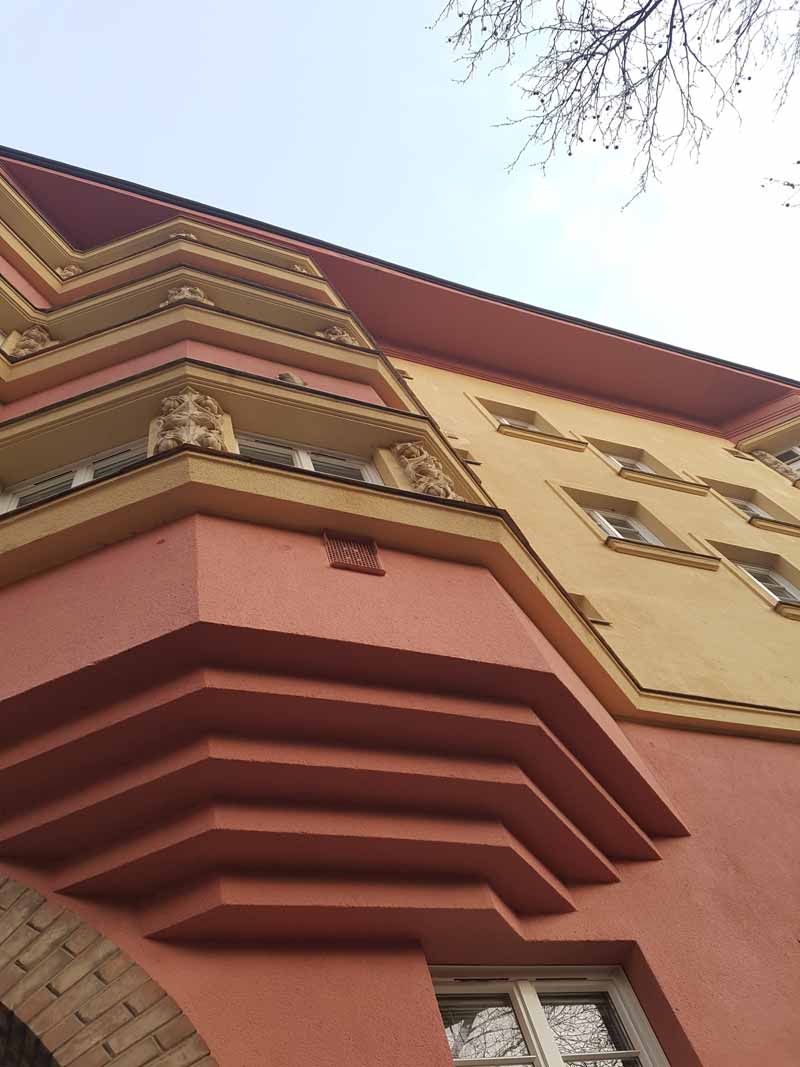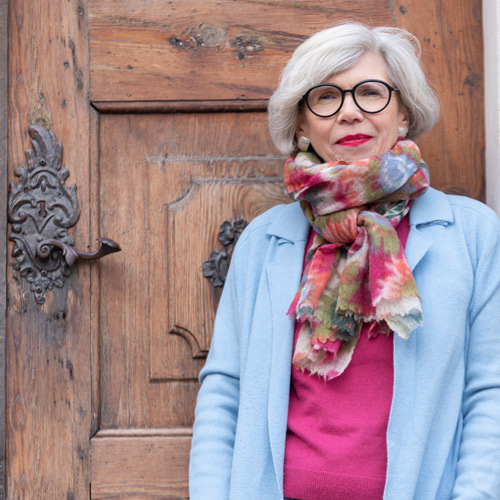The Bieler Hof in Floridsdorf – an urban sign of gratitude and a story from my father
The Biel Court
During my walks with the dog in the 21st district,where we live I often pass the Bieler Hof. It is one of the most beautiful municipal buildings from the era of Red Vienna and with its red (and yellow) façade is virtually a flag bearer for this time. For a long time it was also called the “Red Castle” and with its bay windows, porches and ornaments it really reminds of a romantic castle complex. Located on Kinzerplatz, the building was erected in 1926/1927, its architect was Adolf Stöckl, who worked for the Vienna City Building Office.
The Bieler Hof got its present name only in 1947. This was to honor the city of Biel in Switzerland, which initiated a relief effort for the Floridsdorf population after World War II. A plaque on the building commemorates this.
Incidentally, the Bieler Hof is not alone in this: the Zürcher Hof in Laxenburger Strasse also bears its name in memory of the help given by the city of Zurich to starving Vienna after 1945.


1945 – Vienna in distress
After the end of the Second World War, the need in Vienna was great and the food supply for the population was in a catastrophic state. The city‘s infrastructure was destroyed and it was almost impossible for people to get food. Immediately after liberation, therefore, food supply was the most urgent problem for the Soviet troops. The Soviets’ donations of peas became legendary. But they could only satisfy the most immediate hunger – and the Viennese perceived primarily the worms in the peas and the looting by soldiers of the Red Army.
In September 1945, food distribution began in the British, American and French sectors. After that, the Viennese had to deal with five different supply areas (the 1st district was an inter-allied zone and thus organized in its own way) and five different ration cards, each valid in only one sector.
Moreover, the supply was not the same in all zones. The Viennese thought it was best in the American sector.
CARE packages
Nevertheless, the supply situation continued to deteriorate; rations were fixed at 1,550 calories per day in the fall of 1945. They were reduced to 1,200 calories in March 1946, later they dropped to 960. The allied forces, with the exception of the United States, struggled to feed their own populations, yet they knew they could not abandon Austria.
In this situation, numerous public and private aid organizations from many countries became active. Significant were especially actions from Switzerland, Sweden, Denmark, Great Britain, the USA, Belgium, the Netherlands and donation actions of the Red Cross.
One of the most famous was the CARE campaign (“Cooperative for American Remittances to Europe”). In July 1946, the first of the legendary food parcels arrived in Vienna.
Swiss children
Within the framework of Kindernothilfe, Swiss host families also took in children from Germany and Austria for stays of several months. These guest children were called “Swiss children“. My father was one of them and stayed with a family in Landquart in Graubünden for a few months when he was almost 6 years old. He often told how he had adapted there so quickly and completely in terms of language that his parents could no longer understand him when he returned to Vienna. Perhaps his lifelong interest in dialects was founded then.
My father and my grandparents have remained attached to Switzerland all their lives with good feelings. I myself had Swiss children’s books as a child and was quite surprised to find out that my Viennese friends didn’t know them.
A few years ago, I discovered a commemorative plaque on the grille of the Liechtenstein Garden Palace commemorating the “Swiss children” who gathered there for transport to their host families. I find it very touching to imagine how my father as a boy marched from his home near Vienna’s General Hospital, probably at the hand of his parents and with a small suitcase, the not so far way to Liechtensteinstraße to leave for a time in Switzerland. What a certainly very exciting and overall happy turn of events in his young life.
In any case, I have retained the gratitude that the Swiss donation fed and strengthened my father, who was a very skinny boy in 1946. Maybe I wouldn’t be here otherwise.
The Bieler Hof, with its beauty and dignity, is therefore a particularly dear destination to me on my walks.


Swiss donation
In Switzerland, from 1944 to 1948, public collections were held under the name “Swiss Donation” to express solidarity with the victims of the Second World War. The most urgent need was help against hunger, cold and homelessness, and disease. The implementation of aid abroad was mainly carried out by the Swiss Red Cross and other aid organizations. In cooperation with UNESCO, the Swiss donation also assisted in education by rebuilding schools and libraries and organizing courses and scholarships.
In Vienna, over 120,000 children were provided with hot meals at schools. This “Schülerausspeisung” was proverbial with my parents all their lives – even if, according to their stories, they did not always agree with the taste of what was offered.
In 1946, all schoolchildren in Vienna received a bar of chocolate at the start of school and at Christmas.
By the end of 1946, the following deliveries of Swiss donations had been made to Vienna, Lower Austria and Burgenland: 8,700 tons of food, medicines, medical supplies and medical aids, 33,000 kilograms of textiles, 25,000 pairs of shoes. Stays in Arosa and Davos were organized for Viennese children suffering from tuberculosis.



